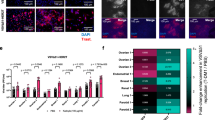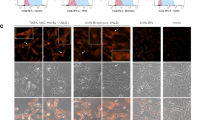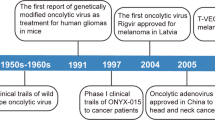Abstract
Although oncolytic viruses have shown great promise as cancer therapeutics, results from a recent phase III clinical trial indicate that their potency may need further improvement for a clear clinical benefit. Here, we report a novel strategy to increase the bystander effect of virotherapy by arming an oncolytic virus with a secreted form of a Her2 single chain antibody linked to a self-multimerizing Fas ligand extracellular domain (Her2-COL-sFasL). The rationale is that, due to its much smaller size, this apoptosis activator can overcome obstacles such as the dense collagen in the tumor tissues to spread more freely than the viral particles. When measured in vitro, Her2-COL-sFasL was found to efficiently induce caspase cleavage, resulting in an 80% reduction in cell viability. Once incorporated into the genome of an oncolytic type 2 herpes simplex virus, FusOn-H3, Her2-COL-sFasL potentiates the therapeutic efficacy of the virus in an aggressive syngeneic mammary tumor model. Our data suggest that arming an oncolytic virus with a secretable and self-multimerizing apoptosis inducer is a feasible strategy to improve the potency of virotherapy.
This is a preview of subscription content, access via your institution
Access options
Subscribe to this journal
Receive 6 print issues and online access
$259.00 per year
only $43.17 per issue
Buy this article
- Purchase on SpringerLink
- Instant access to full article PDF
Prices may be subject to local taxes which are calculated during checkout






Similar content being viewed by others
References
Fu X, Tao L, Cai R, Prigge J, Zhang X . A mutant type 2 herpes simplex virus deleted for the protein kinase domain of the ICP10 gene is a potent oncolytic virus. Mol Ther 2006; 13: 882–890.
Wildner O, Blaese RM, Morris JC . Therapy of colon cancer with oncolytic adenovirus is enhanced by the addition of herpes simplex virus-thymidine kinase. Cancer Res 1999; 59: 410–413.
Bauzon M, Jin F, Kretschmer P, Hermiston T . In vitro analysis of cidofovir and genetically engineered TK expression as potential approaches for the intervention of ColoAd1-based treatment of cancer. Gene Therapy 2009; 16: 1169–1174.
Fu X, Tao L, Jin A, Vile R, Brenner M, Zhang X et al. Expression of a fusogenic membrane glycoprotein by an oncolytic herpes simplex virus provides potent synergistic anti-tumor effect. Mol Ther 2003; 7: 748–754.
Ebert O, Shinozaki K, Kournioti C, Park MS, Garcia-Sastre A, Woo SL et al. Syncytia induction enhances the oncolytic potential of vesicular stomatitis virus in virotherapy for cancer. Cancer Res 2004; 64: 3265–3270.
Simpson GR, Han Z, Liu B, Wang Y, Campbell G, Coffin RS et al. Combination of a fusogenic glycoprotein, prodrug activation, and oncolytic herpes simplex virus for enhanced local tumor control. Cancer Res 2006; 66: 4835–4842.
Guedan S, Grases D, Rojas JJ, Gros A, Vilardell F, Vile R et al. GALV expression enhances the therapeutic efficacy of an oncolytic adenovirus by inducing cell fusion and enhancing virus distribution. Gene Therapy 2012; 19: 1048–1057.
Mok W, Boucher Y, Jain RK . Matrix metalloproteinases-1 and -8 improve the distribution and efficacy of an oncolytic virus. Cancer Res 2007; 67: 10664–10668.
Medema JP, Scaffidi C, Kischkel FC, Shevchenko A, Mann M, Krammer PH et al. FLICE is activated by association with the CD95 death-inducing signaling complex (DISC). EMBO J 1997; 16: 2794–2804.
Muzio M, Salvesen GS, Dixit VM . FLICE induced apoptosis in a cell-free system. Cleavage of caspase zymogens. J Biol Chem 1997; 272: 2952–2956.
Ashkenazi A, Pai RC, Fong S, Leung S, Lawrence DA, Marsters SA et al. Safety and antitumor activity of recombinant soluble Apo2 ligand. J Clin Invest 1999; 104: 155–162.
Walczak H, Miller RE, Ariail K, Gliniak B, Griffith TS, Kubin M et al. Tumoricidal activity of tumor necrosis factor-related apoptosis-inducing ligand in vivo. Nat Med 1999; 5: 157–163.
Younes A, Vose JM, Zelenetz AD, Smith MR, Burris HA, Ansell SM et al. A phase 1b/2 trial of mapatumumab in patients with relapsed/refractory non-Hodgkin's lymphoma. Br J Cancer 2010; 103: 1783–1787.
Herbst RS, Eckhardt SG, Kurzrock R, Ebbinghaus S, O'Dwyer PJ, Gordon MS et al. Phase I dose-escalation study of recombinant human Apo2L/TRAIL, a dual proapoptotic receptor agonist, in patients with advanced cancer. J Clin Oncol 2010; 28: 2839–2846.
Wakelee HA, Patnaik A, Sikic BI, Mita M, Fox NL, Miceli R et al. Phase I and pharmacokinetic study of lexatumumab (HGS-ETR2) given every 2 weeks in patients with advanced solid tumors. Ann Oncol 2010; 21: 376–381.
Tamura K, Wakimoto H, Agarwal AS, Rabkin SD, Bhere D, Martuza RL et al. Multimechanistic tumor targeted oncolytic virus overcomes resistance in brain tumors. Mol Ther 2013; 21: 68–77.
Zhou W, Zhu H, Chen W, Hu X, Pang X, Zhang J et al. Treatment of patient tumor-derived colon cancer xenografts by a TRAIL gene-armed oncolytic adenovirus. Cancer Gene Ther 2011; 18: 336–345.
Cao X, Yang M, Wei RC, Zeng Y, Gu JF, Huang WD et al. Cancer targeting Gene-Viro-Therapy of liver carcinoma by dual-regulated oncolytic adenovirus armed with TRAIL gene. Gene Therapy 2011; 18: 765–777.
Schneider P, Holler N, Bodmer JL, Hahne M, Frei K, Fontana A et al. Conversion of membrane-bound Fas(CD95) ligand to its soluble form is associated with downregulation of its proapoptotic activity and loss of liver toxicity. J Exp Med 1998; 187: 1205–1213.
Holler N, Tardivel A, Kovacsovics-Bankowski M, Hertig S, Gaide O, Martinon F et al. Two adjacent trimeric Fas ligands are required for Fas signaling and formation of a death-inducing signaling complex. Mol Cell Biol 2003; 23: 1428–1440.
Berg D, Lehne M, Muller N, Siegmund D, Munkel S, Sebald W et al. Enforced covalent trimerization increases the activity of the TNF ligand family members TRAIL and CD95L. Cell Death Diff 2007; 14: 2021–2034.
Ogasawara J, Watanabe-Fukunaga R, Adachi M, Matsuzawa A, Kasugai T, Kitamura Y et al. Lethal effect of the anti-Fas antibody in mice. Nature 1993; 364: 806–809.
Li X, Liu YH, Zhang YP, Zhang S, Pu X, Gardner TA et al. Fas ligand delivery by a prostate-restricted replicative adenovirus enhances safety and antitumor efficacy. Clin Cancer Res 2007; 13: 5463–5473.
Arai H, Gordon D, Nabel EG, Nabel GJ . Gene transfer of Fas ligand induces tumor regression in vivo. Proc Natl Acad Sci USA 1997; 94: 13862–13867.
Aoki K, Akyurek LM, San H, Leung K, Parmacek MS, Nabel EG et al. Restricted expression of an adenoviral vector encoding Fas ligand (CD95L) enhances safety for cancer gene therapy. Mol Ther 2000; 1: 555–565.
Hyer ML, Sudarshan S, Schwartz DA, Hannun Y, Dong JY, Norris JS et al. Quantification and characterization of the bystander effect in prostate cancer cells following adenovirus-mediated FasL expression. Cancer Gene Ther 2003; 10: 330–339.
Muruve DA, Nicolson AG, Manfro RC, Strom TB, Sukhatme VP, Libermann TA et al. Adenovirus-mediated expression of Fas ligand induces hepatic apoptosis after Systemic administration and apoptosis of ex vivo-infected pancreatic islet allografts and isografts. Human Gene Therapy 1997; 8: 955–963.
Fan CY, Huang CC, Chiu WC, Lai CC, Liou GG, Li HC et al. Production of multivalent protein binders using a self-trimerizing collagen-like peptide scaffold. FASEB J 2008; 22: 3795–3804.
Boatright KM, Renatus M, Scott FL, Sperandio S, Shin H, Pedersen IM et al. A unified model for apical caspase activation. Mol Cell 2003; 11: 529–541.
Nakano M, Odaka K, Takahashi Y, Ishimura M, Saito I, Kanegae Y et al. Production of viral vectors using recombinase-mediated cassette exchange. Nucleic Acids Res 2005; 33: e76.
Fu X, Tao L, Jin A, Vile R, Brenner MK, Zhang X et al. Expression of a fusogenic membrane glycoprotein by an oncolytic herpes simplex virus potentiates the viral antitumor effect. Mol Ther 2003; 7: 748–754.
Milligan GN, Bernstein DI . Generation of humoral immune responses against herpes simplex virus type 2 in the murine female genital tract. Virology 1995; 206: 234–241.
Shah AC, Price KH, Parker JN, Samuel SL, Meleth S, Cassady KA et al. Serial passage through human glioma xenografts selects for a Deltagamma134.5 herpes simplex virus type 1 mutant that exhibits decreased neurotoxicity and prolongs survival of mice with experimental brain tumors. J Virol 2006; 80: 7308–7315.
Li H, Dutuor A, Fu X, Zhang X . Induction of strong antitumor immunity by an HSV-2-based oncolytic virus in a murine mammary tumor model. J Gene Med 2007; 9: 161–169.
Russell SJ, Peng KW, Bell JC . Oncolytic virotherapy. Nat Biotechnol 2012; 30: 658–670.
Bartlett DL, Liu Z, Sathaiah M, Ravindranathan R, Guo Z, He Y et al. Oncolytic viruses as therapeutic cancer vaccines. Mol Cancer 2013; 12: 103.
Schneider B, Munkel S, Krippner-Heidenreich A, Grunwald I, Wels WS, Wajant H et al. Potent antitumoral activity of TRAIL through generation of tumor-targeted single-chain fusion proteins. Cell death Dis 2010; 1: e68.
Samel D, Muller D, Gerspach J, Assohou-Luty C, Sass G, Tiegs G et al. Generation of a FasL-based proapoptotic fusion protein devoid of systemic toxicity due to cell-surface antigen-restricted activation. J Biol Chem 2003; 278: 32077–32082.
Bremer E, Samplonius DF, Peipp M, van Genne L, Kroesen BJ, Fey GH et al. Target cell-restricted apoptosis induction of acute leukemic T cells by a recombinant tumor necrosis factor-related apoptosis-inducing ligand fusion protein with specificity for human CD7. Cancer Res 2005; 65: 3380–3388.
Bremer E, ten Cate B, Samplonius DF, Mueller N, Wajant H, Stel AJ et al. Superior activity of fusion protein scFvRit:sFasL over cotreatment with rituximab and Fas agonists. Cancer Res 2008; 68: 597–604.
Trebing J, El-Mesery M, Schafer V, Weisenberger D, Siegmund D, Silence K et al. CD70-restricted specific activation of TRAILR1 or TRAILR2 using scFv-targeted TRAIL mutants. Cell Death Dis 2014; 5: e1035.
Sathaiah M, Thirunavukkarasu P, O'Malley ME, Kavanagh MA, Ravindranathan R, Austin F et al. Oncolytic poxvirus armed with Fas ligand leads to induction of cellular Fas receptor and selective viral replication in FasR-negative cancer. Cancer Gene Ther 2012; 19: 192–201.
Barash S, Wang W, Shi Y . Human secretory signal peptide description by hidden Markov model and generation of a strong artificial signal peptide for secreted protein expression. Biochem Biophys Res Commun 2002; 294: 835–842.
Wels W, Harwerth IM, Zwickl M, Hardman N, Groner B, Hynes NE et al. Construction, bacterial expression and characterization of a bifunctional single-chain antibody-phosphatase fusion protein targeted to the human erbB-2 receptor. Bio/technology (Nature Publishing Company) 1992; 10: 1128–1132.
Lee G, Saito I . Role of nucleotide sequences of loxP spacer region in Cre-mediated recombination. Gene 1998; 216: 55–65.
Livet J, Weissman TA, Kang H, Draft RW, Lu J, Bennis RA et al. Transgenic strategies for combinatorial expression of fluorescent proteins in the nervous system. Nature 2007; 450: 56–62.
Goins WF, Krisky DM, Wechuck JB, Wolfe D, Huang S, Glorioso JC et al. Generation of replication-competent and -defective HSV vectors. Cold Spring Harb Protoc 2011; 2011: pdb.prot5615.
Acknowledgements
We thank Xinping Fu, Lihua Tao, Armando Rivera, Kim Anthony-Gonda and Jeffrey Spencer for the sharing of their expertise for a variety of techniques. Also, we further thank Armando Rivera, Kim Anthony-Gonda and Jeffrey Spencer for reading of the manuscript before submission. This work was supported by the National Cancer Institute grants R01CA106671 and R01CA132792 and also by a grant from the William and Ella Owens Medical Research Foundation (to XZ).
Author information
Authors and Affiliations
Corresponding author
Ethics declarations
Competing interests
The authors declare no conflict of interest.
Additional information
Supplementary Information accompanies this paper on Gene Therapy website
Supplementary information
Rights and permissions
About this article
Cite this article
Loya, S., Zhang, X. Enhancing the bystander killing effect of an oncolytic HSV by arming it with a secretable apoptosis activator. Gene Ther 22, 237–246 (2015). https://doi.org/10.1038/gt.2014.113
Received:
Revised:
Accepted:
Published:
Issue Date:
DOI: https://doi.org/10.1038/gt.2014.113



